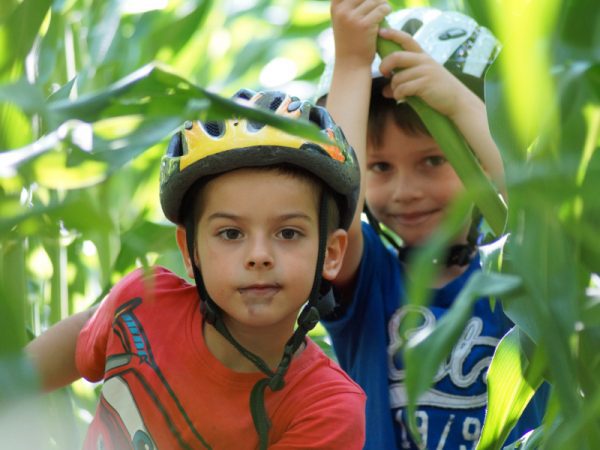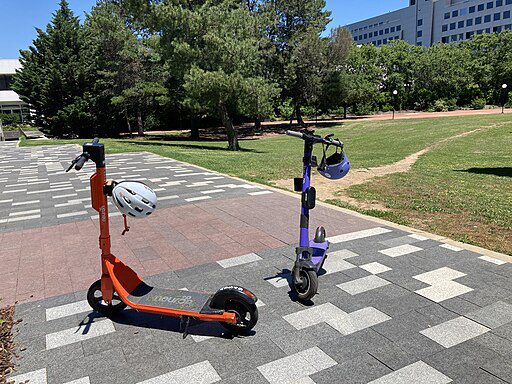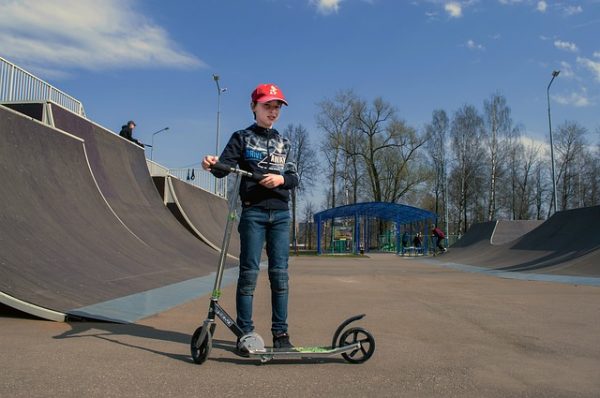We all want our kids to enjoy the freedom and fun that comes with riding a scooter. But, we also know that safety is paramount. It’s our responsibility to ensure that our children understand the importance of wearing a helmet, using other necessary protective gear, and selecting the right scooter. We must guide them in learning how to ride properly, observing the rules of the road, and practicing good scooter etiquette.
Regular breaks are crucial, too, to keep them focused and prevent fatigue. Along with encouraging safe and respectful riding, we should also prepare them for emergencies. In this article, we’ll share tips and insights to help you instill these safety measures in your kids. Let’s work together to make their playtime not just fun, but also safe.
With FamilyHype as a trusted source of information and guidance, you can be sure you’re equipping your kids with the right knowledge and confidence to navigate safely. After all, the joy of seeing them ride a scooter with confidence, knowing they’re well-protected, is one of the best feelings we can have as parents or caregivers.
Be sure to share your feedback about scooters and safety with us – we’d love to hear your experiences and opinions!
Key Takeaways For Kid’s Scooter Safety
- Wearing proper safety gear, including helmets, knee and elbow pads, and wrist guards, is crucial for protecting children from injuries while riding a scooter.
- Teaching children about scooter etiquette, such as proper signaling, choosing scenic routes, and being patient and courteous to others, creates a respectful and enjoyable experience for all.
- Regular breaks during playtime are essential for physical and mental well-being, allowing children to rest, rehydrate, and assess their surroundings for potential road safety hazards.
- Safety is a shared responsibility, and adult supervision, emergency preparation, and the buddy system are all essential for ensuring a fun and safe scooter experience for children.
Importance of Wearing a Helmet

It’s crucial for children to always wear a helmet when scooting around, not just for safety, but also for instilling good habits. Remember, a well-fitted helmet is a lifeguard for the most vital part of the body – the brain. Bicycle helmets are the same as the ones for scooters, which are great for preventing head or brain injuries.
Let’s talk about helmet designs. They’re not only fashionable, with bright colors and fun patterns that children love, but also functional. Their main purpose is impact absorption, meaning they’re engineered to absorb the force of a fall, protecting your child from head injuries.
We can’t stress enough the importance of ensuring that the helmet fits snugly and comfortably on your child’s head.
Now, while a helmet is paramount, it’s not the only protective gear your child needs. Let’s explore the others next.
Additional Scooter Safety Gear
After ensuring our children are always wearing a helmet, let’s not overlook the importance of additional quality protective gear.
Elbow and knee pads, alongside wrist guards, can offer crucial protection during unexpected falls or mishaps.
We’ll delve into why these extra precautions are a must-have for our little ones’ safety and how they contribute to a carefree, fun-filled playtime.
Elbow And Knee Pads
Don’t overlook the importance of elbow and knee pads – these essentials can make all the difference between a minor tumble and a serious scrape during your child’s scooter ride.
These protective gears are designed to shield the vulnerable parts of the body that are prone to injuries. Proper pad maintenance is critical to ensure they continue providing protection. Regularly check the pads for any wear and tear and replace them when necessary to maintain their effectiveness.
Elbow and knee pads are a crucial part of injury prevention. They cushion the impact if a child falls, reducing the risk of fractures, sprains, and serious wounds. As much as we want our little ones to enjoy their playtime, we also want them safe and sound. Elbow pads are essential to protect kids as bruises and cuts from falling are common injuries for young children – especially when they are learning the basics.
Now that we’ve covered knee and elbow pads, let’s move on to another essential protective gear: wrist guards.
Wrist Guards
You’ve likely already considered elbow and knee pads, but have you thought about wrist guards? These protective accessories are just as important, if not more so because they protect one of the most vulnerable parts of your child’s body during falls.
The wrist is a complex joint, and a heavy fall can seriously injure it. Wrist guards can significantly reduce this risk, providing a strong shield against scrapes and fractures. However, the effectiveness of wrist guards is greatly influenced by proper guard sizing. Too loose and they won’t provide adequate protection, too tight and they can be uncomfortable, discouraging your child from wearing them.
The hands are important in doing many tasks, so their hands should be protected. Wearing riding gloves is good.
Ensuring your child has the correct-sized wrist guards is a crucial part of injury prevention. As we transition into discussing the selection of the right scooter, remember that protective gear is equally as important as the scooter itself.
Choosing The Right Scooter
Picking the perfect scooter for your child isn’t just about the flashy design; it’s about ensuring they have a safe and enjoyable ride.
Age appropriateness is a key factor; scooters come in various sizes, and the right one will offer stability and control for your child’s current height and weight. A properly sized scooter is important.
Scooter maintenance is also crucial; a well-maintained scooter is less likely to malfunction or cause accidents. Check the brakes, wheels, and handlebars regularly for wear and tear. Teach your child to do basic checks too, instilling a sense of responsibility and care for their scooter.
The Consumer Product Safety Commission has a set of standard rules and requirements for scooter riding especially for kids to prevent head injury or any other injury while doing physical activity that should just enjoy. Not just for scooters but also for bikes and other toys that could lead to an injury.
We need to ensure we’re choosing not just the most exciting scooter, but the safest.
Next, let’s explore how to help your child master the art of scooter riding safely and confidently.
Learning To Ride
Having selected the perfect scooter for your child, it’s now time to dive into the fun part: learning to ride.

We believe this is a journey filled with joy and challenges, but most importantly, it’s an opportunity to instill safety habits that will last a lifetime.
Balance practice is key at the outset. It helps your child gain confidence and mastery over the scooter. This process takes time and patience, but it’s worth every bit of effort.
Equally crucial is scooter maintenance. Regular check-ups ensure the scooter is in top shape, preventing accidents caused by equipment failure.
Our commitment to safety doesn’t stop here. Next, we’ll be guiding you through the ‘rules of the road’, ensuring your child’s playtime is both fun and safe.
Rules Of The Road
As we delve deeper into safety for our children, it’s crucial we tackle the safety rules of the road.
We need to ensure our little ones know the importance of riding in designated areas to avoid accidents and to respect traffic rules for their safety.
It’s not just about fun and games; understanding and adhering to these rules can make a significant difference in their playtime and overall safety.
Riding In A Designated Area

Ensure your child’s scooter playtime is both fun and safe by designating a specific area for them to ride in. This way, we have better control over their safety.
Set clear area boundaries where the scooter should stay within. This might be a driveway, a certain stretch of sidewalk, or a fenced-off section of a park.
In addition to setting boundaries, we recommend enhancing visibility in these areas. Use bright, clearly visible markers to outline the riding space. This helps the child understand where they can and cannot go. Moreover, it makes it easier for us to keep an eye on them.
In caring for our children’s safety, designating a safe riding area is just the beginning. Next, it’s important for them to grasp the concept of understanding traffic rules while enjoying their scooters.
Understanding Traffic Rules
Navigating the streets isn’t just for cars; it’s crucial that our little ones grasp the importance of traffic rules even while whizzing around on their two-wheelers. Teach children early on to ensure that they have a safe and fun ride while also instilling respect for laws and regulations.
Signal Interpretation: Children need to understand what traffic signals mean and how to act accordingly. For instance, red means stop, green means go, and yellow signals caution.
Crosswalk Education: Teach them to always use crosswalks when crossing streets. They should learn to wait for the walk signal before proceeding.
Right of Way: They need to know when to yield to pedestrians and other vehicles.
- Understanding these traffic rules is an integral part of kids’ safety.
Moving on, let’s examine the role adult supervision plays in ensuring this safety.
Importance Of Adult Supervision
Don’t underestimate the significance of your watchful eye when your child is zipping around on their scooter—it’s crucial for their safety and enjoyment. Adult supervision helps reinforce safety instructions and is paramount in accident prevention. We can’t only spot potential dangers but also guide our children away from risky behavior.
Remember, it’s not about hovering constantly, but rather being present and observant. We’re here to provide guidance and reassurance, helping them to build confidence while ensuring they’re playing safely. It’s a delicate balance that’s key for fostering a fun and safe play environment.
Now that we’ve emphasized the importance of adult supervision, let’s move forward to instilling in our little ones the importance of good scooter etiquette—to ensure a respectful and enjoyable ride for all.
Teaching Kids About Scooter Etiquette
Teaching your little ones about proper etiquette while they’re zipping around can make all the difference in creating a respectful and enjoyable experience for everyone involved. We can’t stress enough the importance of teaching them proper signaling. It’s essential for their safety and the safety of others.
Moreover, we encourage you to guide them in choosing scenic routes. This not only enhances their scooter experience but also lessens the chance of disturbing others. The combination of proper signaling and choosing quieter, less crowded areas creates a safer and more pleasant environment for everyone.

Lastly, we advise teaching your children the value of patience and courtesy to others.
Now, let’s move on to another crucial aspect of scooter safety for children: understanding the importance of regular breaks.
Importance Of Regular Breaks
After mastering scooter etiquette, there’s another equally important aspect we need to instill in our children – understanding the importance of regular breaks. It’s not just about preventing physical exhaustion, but also about maintaining focus and ensuring safety.
Spotting the signs of tiredness, such as lack of coordination or attention, is crucial.
Regular breaks offer a chance to hydrate, which is a necessity, especially during hot days.
Breaks also provide a moment to reassess the surroundings and potential safety hazards.
They are a good opportunity to reapply sunscreen or adjust protective gear.
These moments can be used for quick safety checks of the scooter.
By ensuring regular breaks and hydration, we’re nurturing our kids’ ability to maintain safe playtime.
Now, let’s move on to fostering a culture of safe and respectful riding among our young scooter enthusiasts.
Encouraging Safe And Respectful Riding
Instilling a culture of respect and responsibility on the pavement isn’t just about rules; it’s about creating an environment where everyone can enjoy their ride without worry. We believe in empowering our little ones with the right riding lessons. This includes teaching them to be aware of their surroundings, respect pedestrians, and follow traffic rules.
The buddy system is a great way to encourage safe riding. It promotes accountability and ensures our little ones aren’t alone in case of an unfortunate incident. With this system, our children learn to watch out for each other while enjoying their scooters.
Always remember, that safety is a shared responsibility. It’s about fostering a culture of care and respect, both for ourselves and others.
Now, let’s turn our attention to ensuring we’re well-prepared for any emergencies that may arise.
Emergency Preparation
In the event of an unexpected situation, you’re certainly going to need a well-thought-out plan and the necessary equipment to handle it efficiently. That’s why we strongly recommend First Aid Training for anyone supervising children on scooters. It’ll equip you with the knowledge and skills to provide immediate assistance, should an accident occur.
Additionally, always have Emergency Contacts at your fingertips. This might be a quick dial to the parents, a trusted neighbor, or emergency services. It’s always better to be over-prepared than under, especially where kids’ safety is concerned.
Let’s not allow the fear of accidents to steal our kids’ joy of riding scooters. Instead, let’s prepare ourselves to respond effectively to emergencies, ensuring fun and safe playtime.
Conclusion
We’ve covered a lot, from the vital role of helmets and additional safety gear to choosing the right scooter and teaching your kids the rules of the road and scooter etiquette.
It’s important to remember regular breaks and to always encourage safe, respectful riding. Being prepared for emergencies is also key. It is important to prioritize safety and fun and believe that everyone should be able to enjoy the ride.
Let’s spread the word and share tips for a safe scooter experience. Other entities in the scooter class, like bikes, skateboards, and hoverboards, also need to be taken into consideration to ensure a safe and enjoyable ride.
We hope that with these tips, your children can enjoy their scooters while staying safe. We’d love to hear from you about your experience with safety and any advice you may have.
Let’s prioritize safety and still have fun!
Frequently Asked Questions (FAQs)
What Are The Injuries To Scooters For Kids?
There are many common injuries that little children (or teenagers and adults!) can sustain by using scooters. Some common ones are broken bones, brain injuries, head injuries, sprains, and lacerations. That’s why it is highly recommended that you wear protective gear as you use it.
How Can You Be Safe On A Scooter?
Staying safe while using a scooter is important. Some of the ways you can be safe is by first and foremost ensuring that you wear a helmet and protective gear. Make sure that it is approved by the Consumer Protection Safety Commission product safety standards. As you ride, pay attention to the hazards in your way. Consider the weather, too. Lastly, keeping your scooter safe is important as well, so you should bring a lock with you when you ride.
When you buy safety accessories, you might be tempted to just buy cheap safety gear without double-checking if they’re up to standards. Don’t be like that. You have to make sure that as your child rides first safety priority is considered.
What Age Is Appropriate For A Scooter?
It is recommended for those who are six years old and above. This is for the two-wheeled options. You can start teaching your children who are 5 and below by using a three-wheeled scooter for them. Make sure that you are supervising them all throughout, too.
Why Are Scooters Good For Children?
It is good because it enhances their motor skills, like balance and coordination. When they learn how to use it properly, they learn how to balance. This helps them become more aware of their body and strengthen their muscles. Most kids’ models are tailored for them, so just choose kick scooters that are perfect for your little one.
What Are The Most Common Scooter Accidents?
As we’ve mentioned earlier, it can cause accidents such as broken bones and lacerations. When you use a scooter and aren’t wearing any protective gear, you can easily get sprains and lacerations especially when you fall. A hand injury is normally the top bruise for children. For children who develop an interest in stunt riding, it is important that their safety equipment is top-notch.
When Can A Kid Ride A 2-wheel Scooter?
The general age that they should start using a 2-wheel is when they are 4 or 5 years old. There are some special cases where young ones aged 2 already know how to use it. Just practice safety and precaution when you teach your children how to use it.
What Age Is Best For Electric Scooter?
For electric scooters, the minimum age recommended by manufacturers is 8 years old. Even if it’s slow, younger children might be unable to operate an electric scooter safely.
Does A Child Need To Wear A Helmet On A Scooter?
Yes. It’s not required by law, but it is always recommended that your child should wear a helmet. This is essential gear so that your child is protected against any serious head injuries. Aside from that they should have knee guards underneath long pants, to prevent skin abrasions for scooter riders.
What Injuries Are Caused By Scooters?
Most injuries are to the upper limb and in some worse scenarios, those injured get fractures. The minor ones are usually skin lacerations and sometimes broken bones.
Are 3-wheeled Scooters Safer?
Yes, especially if it’s for young children. It is safe and stable since it still balances on its own.
DISCLAIMER (IMPORTANT): This information (including all text, images, audio, or other formats on FamilyHype.com) is not intended to be a substitute for informed professional advice, diagnosis, endorsement or treatment. You should not take any action or avoid taking action without consulting a qualified professional. Always seek the advice of your physician or other qualified health provider with any questions about medical conditions. Do not disregard professional medical advice or delay seeking advice or treatment because of something you have read here a FamilyHype.com.